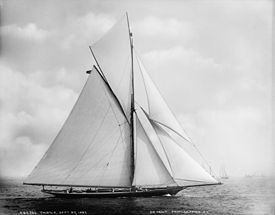
The America's Cup, affectionately known as the Auld Mug, is a trophy awarded to the winner of the America's Cup match races between two sailing yachts. One yacht, known as the defender, represents the yacht club that currently holds the America's Cup and the second yacht, known as the challenger, represents the yacht club that is challenging for the cup. The timing of each match is determined by an agreement between the defender and the challenger. The America's Cup is the oldest international sporting trophy. The next competition for the cup will take place in March 2021.

Vigilant was the victorious United States defender of the eighth America's Cup in 1893 against British challenger Valkyrie II. Vigilant was designed by Nathanael Greene Herreshoff and built in 1893 by the Herreshoff Manufacturing Company of Bristol, Rhode Island. She was Herreshoff's first victorious America's Cup defender design.
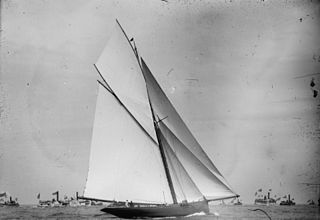
Genesta was the unsuccessful English challenger in the fifth America's Cup in 1885 against the American defender Puritan.

Shamrock was a racing yacht built in 1898 that was the unsuccessful Irish challenger for the 1899 America's Cup against the United States defender, Columbia.

Volunteer was an American racing yacht built in 1887 for the America's Cup races. She was the victorious American defender of the seventh America's Cup match that same year against Scottish challenger Thistle.

Valkyrie III, officially named Valkyrie, was the unsuccessful British challenger of the ninth America's Cup race in 1895 against American defender Defender.

Columbia was an American racing yacht built in 1899 for the America's Cup races. She was the defender of the tenth America's Cup race that same year against British challenger Shamrock as well as the defender of the eleventh America's Cup race in 1901 against British challenger Shamrock II. She was the first vessel to win the trophy twice in a row

Valkyrie II, officially named Valkyrie, was a British racing yacht that was the unsuccessful challenger of the 1893 America's Cup race against American defender Vigilant.

His Majesty's Yacht Britannia was a gaff-rigged cutter built in 1893 for RYS Commodore Albert Edward, Prince of Wales. She served both himself and his son King George V with a long racing career.
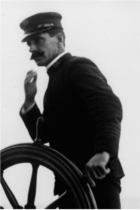
Charles Barr, was an accomplished sailing skipper who three times captained winning America's Cup yachts.

Alexander Robertson & Sons was a boatyard in Sandbank, Argyll and Bute, Scotland, from 1876 to 1980. The yard was located on the shore of the Holy Loch, near the world famous Royal Clyde Yacht Club (RCYC) at Hunter's Quay, in the building that is now the Royal Marine Hotel which was the epicentre of early Clyde yachting. Alexander Robertson started repairing boats in a small workshop at Sandbank, Argyll in 1876, and went on to become one of the foremost wooden boat-builders on Scotland's River Clyde. The 'golden years' of Robertson's yard were in the early 1900s when they started building some of the first IYRU 12mR & 15mR racing yachts. Robertson's was well known for the quality of its workmanship and was chosen to build the first 15-metre yacht designed by William Fife III. More than 55 boats were built by Robertson's in preparation for the First World War and the yard remained busy even during the Great Depression in the 1930s, as many wealthy businessmen developed a passion for yacht racing on the Clyde. During World War II the yard was devoted to Admiralty work, producing a wide range of large high speed Fairmile Marine Motor Boats. After the war the yard built the successful one-class Loch Longs and two 12-metre challengers for the America's Cup: Sceptre (1958) and Sovereign (1964). Due to difficult business conditions the Robertson family sold the yard in 1965, and it was turned over to GRP production work until it closed in 1980. During its 104-year history, Robertson's Yard built 482 numbered boats, many of which are still sailing today.

George Lennox Watson was a Scottish naval architect. He was born in Glasgow, son of Thomas Lennox Watson, a doctor at the Glasgow Royal Infirmary, and grandson of Sir Timothy Burstall, engineer and entrant at the 1829 Rainhill Trials.

Resolute was a yacht designed and built by Nathanael Greene Herreshoff for a syndicate of New York Yacht Club members headed by Henry Walters to contend the 1914 America's Cup.

David & William Henderson and Company was a Scottish marine engineering and shipbuilding company, based on Clydeside. It was founded in 1872 and traded until 1936. Its shipyard was on the north bank of the River Clyde at its confluence with the River Kelvin.
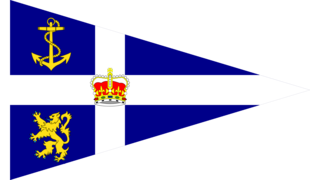
The Royal Northern & Clyde Yacht Club is a yacht club founded in Scotland in 1978, by merger of the Royal Northern Yacht Club and the Royal Clyde Yacht Club.
Events from the year 1887 in Scotland.
The 1895 America's Cup occurred just two years after the 1893 America's Cup pitting the New York Yacht Club against the Royal Yacht Squadron. The 1895 race was between the Herreshoff designed sloop Defender owned by Charles Oliver Iselin, William Kissam Vanderbilt, and Edwin Dennison Morgan from the New York Yacht Club, and the Watson designed Valkyrie III owned by Lord Dunraven of the Royal Yacht Squadron.
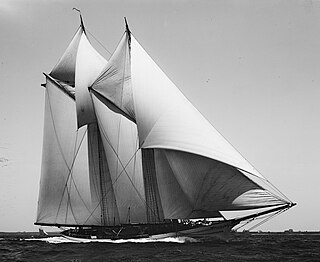
The Yampa was an American ocean-going cruising schooner yacht for pleasure use from 1887 to 1899. The yacht was originally built for Chester W. Chapin, a rail baron and U.S. Congressman from Massachusetts. It completed several ocean cruises with no accidents. It passed through several hands and ultimately was purchased by Kaiser Wilhelm II of Germany as a birthday present for his wife. He had another larger yacht built based on the design of the Yampa, which was named the Meteor III.
Sir James Bell, 1st Baronet, DL JP was a 19th-century Scottish shipping owner and coal-exporter who served as Lord Provost of Glasgow from 1892 to 1896.
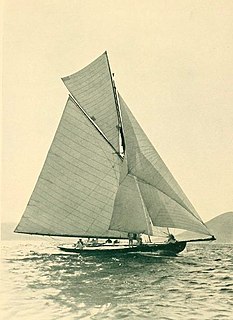
Niagara was a 65-foot (20 m) long sloop built in 1895 by the Herreshoff Manufacturing Company in Bristol, Rhode Island for New Yorker Howard Gould.
